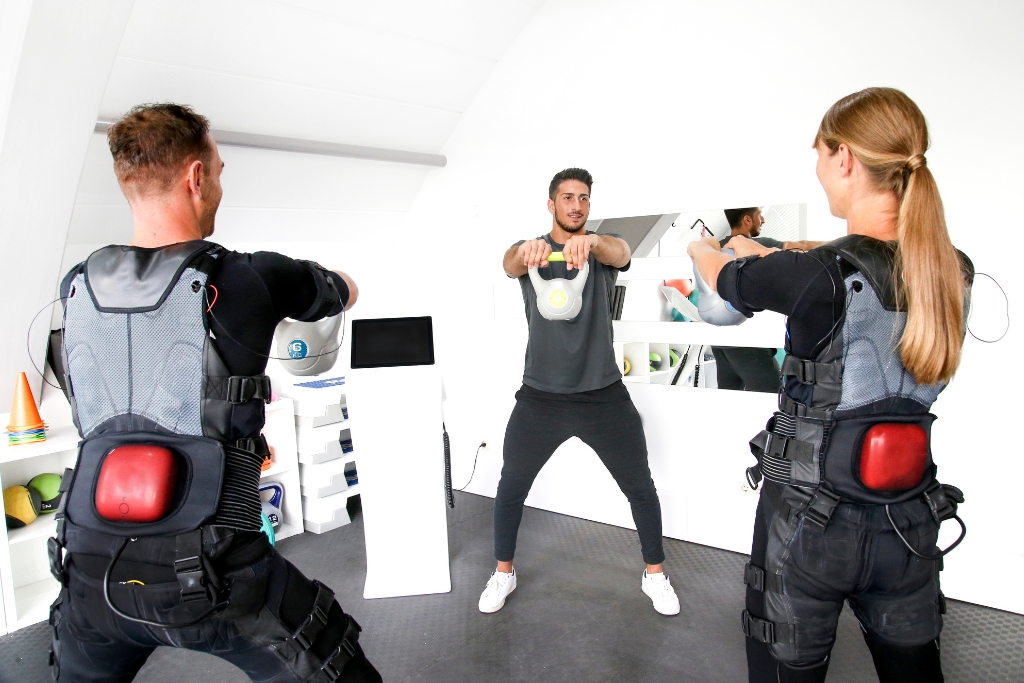Electric Muscle Stimulation Training (also known as EMS training) has gained significant attention in recent years. From celebrities and professional athletes to busy parents and fitness beginners, people across the globe are turning to electro-muscle stimulation training to improve their strength, endurance, and overall health. This modern workout method uses gentle electrical impulses to stimulate muscle contractions, helping users get effective results in less time. It’s efficient, time-saving, and adaptable to nearly every fitness level.
However, despite its rising popularity, EMS training is often misunderstood. A number of common myths and misconceptions continue to circulate, leaving many unsure about its safety, effectiveness, and who it’s actually designed for. If you’re considering EMS or simply curious about how it works, it’s important to understand the truth. In this blog, we’ll clear the air by addressing the top 5 misconceptions about EMS training—and explain why they just don’t hold up.
Misconception 1: EMS Training Is Only for Athletes or Bodybuilders
The Truth: Anyone can benefit from EMS training, no matter their fitness level.
Many people believe that EMS training is only meant for elite athletes or professional bodybuilders. This couldn’t be further from the truth. While it’s true that athletes often use Electric Muscle Stimulation Training to boost their performance or recover faster, the technology is just as useful for everyday people looking to stay active, lose weight, or build muscle.
Whether you’re a stay-at-home parent, a working professional, or someone recovering from an injury, EMS training can be tailored to your needs. With the help of a fitness trainer for the EMS suits, you can adjust the intensity of your workout and focus on the muscle groups that need the most attention.
Today, more people are choosing personal EMS training for injury recovery because it offers flexibility and convenience. You don’t need to be a fitness pro—just someone who wants to get healthier and stronger in a smart, efficient way.
Misconception 2: EMS Training Is Unsafe or Harmful
The Truth: EMS training is safe when guided by a certified trainer.
Another common concern is that electromuscle stimulation training is unsafe, especially since it involves electrical impulses. This can sound scary at first, but EMS training is actually a well-researched and medically approved method when used correctly.
The low-frequency electrical impulses used in EMS are designed to mimic the natural signals your brain sends to your muscles. During a session, your muscles contract just like they would in a traditional workout, but in a more targeted and controlled way. The current used in EMS suits is very low and does not cause any harm to the body when used under professional supervision.
To ensure safety and proper use, it’s always best to work with a personal EMS trainer who understands the equipment and how it interacts with the body. These trainers are trained to guide you through workouts that are both effective and safe. If you’re looking for a more private setting, personal training at home with an EMS suit can still be safe, as long as you follow professional guidance and use certified EMS gear.
Misconception 3: EMS Training Replaces Traditional Exercise Entirely
The Truth: EMS training is a complement to, not a replacement for, regular fitness routines.
Some people think EMS training is a “shortcut” that lets you skip regular exercise altogether. While EMS workouts are incredibly efficient and can provide results in less time, they should not completely replace physical activity. EMS and traditional training should be combined for the best results. EMS training enhances your workout by activating deeper muscle layers that are often hard to reach with regular workouts.
However, it’s best used as part of a well-rounded fitness plan. For example, many people pair EMS sessions with activities like walking, stretching, cardio, or strength training. If you’re short on time or have physical limitations, personal EMS training at home can be a game-changer. Just 20 minutes of EMS training twice a week can bring visible results when done consistently and properly.
But keep in mind—it’s not a magical fix. Staying active and maintaining a balanced lifestyle is still key to long-term health. A qualified EMS personal trainer can help you combine EMS sessions with other types of training based on your goals. That way, you get the best of both worlds.
Misconception 4: You Won’t Break a Sweat With EMS Training
The Truth: EMS workouts are intense and effective—you will feel the burn!
Another myth is that EMS training is “too easy” or doesn’t give you a real workout. Some people expect to just stand still while the suit does all the work. But anyone who has tried a full EMS workout knows this isn’t true at all. During an EMS session, you’re doing exercises like squats, lunges, or core work while the suit stimulates your muscles.
The electrical impulses make your muscles work harder than they normally would, and as a result, your workout becomes more intense, even if it only lasts 20 minutes. Because your entire body is being activated at once, EMS training is actually more demanding than many traditional workouts. You may not need hours at the gym, but you will definitely break a sweat.
Having a personal EMS trainer makes all the difference. They guide your movements, help you push your limits safely, and ensure every muscle group is working efficiently. Whether you’re doing personal training at home or in a studio, EMS training is no walk in the park—but that’s a good thing.
Misconception 5: EMS Results Are Instant or Too Good to Be True
The Truth: EMS training works—but consistency is key.
Some companies or online ads promote EMS training as a miracle method for instant results. While EMS is effective and efficient, it’s not a magic solution that works overnight. Just like any fitness program, results from electro muscle stimulation training depend on your effort, consistency, and overall lifestyle.
Most people start to see noticeable changes in muscle tone, strength, and posture after about 4 to 6 weeks of regular sessions. One of the main benefits of EMS is that it helps activate hard-to-reach muscles more effectively in a shorter time. So while it does work faster than traditional workouts in some ways, it still requires a commitment to get the best results.
When paired with a healthy diet and guided by a certified EMS personal trainer, EMS training can transform your fitness level. But patience and discipline are just as important as the technology itself.
Why More People Are Choosing Personal EMS Training at Home
In today’s busy world, many people are turning to personal EMS training at home to stay fit without sacrificing their schedule. With the help of portable EMS suits and online or in-person support from a personal EMS trainer, you can enjoy the benefits of a full-body workout from the comfort of your living room.
No need to drive to the gym or wait for equipment. With Personal Training at Home, your workouts become more convenient and efficient. Plus, you can tailor the intensity and frequency of each session to fit your fitness goals and lifestyle.
Final Thoughts
Electric muscle stimulation training is one of the most exciting fitness innovations available today. But as with any new technology, there are bound to be some myths and misunderstandings. By taking the time to learn the truth about EMS, you can make better choices about your health and fitness journey.
Whether you’re looking to get toned, stay active, or save time, EMS training offers a smart and science-backed way to reach your goals. Just remember—it’s not a magic fix, but with the right guidance, consistency, and mindset, EMS can be a powerful tool in your fitness toolbox. If you’re curious about starting your own EMS journey, consider working with Personal EMS Training at Home. With the right plan and support, you’ll be surprised at how quickly your body responds to this innovative form of exercise.

